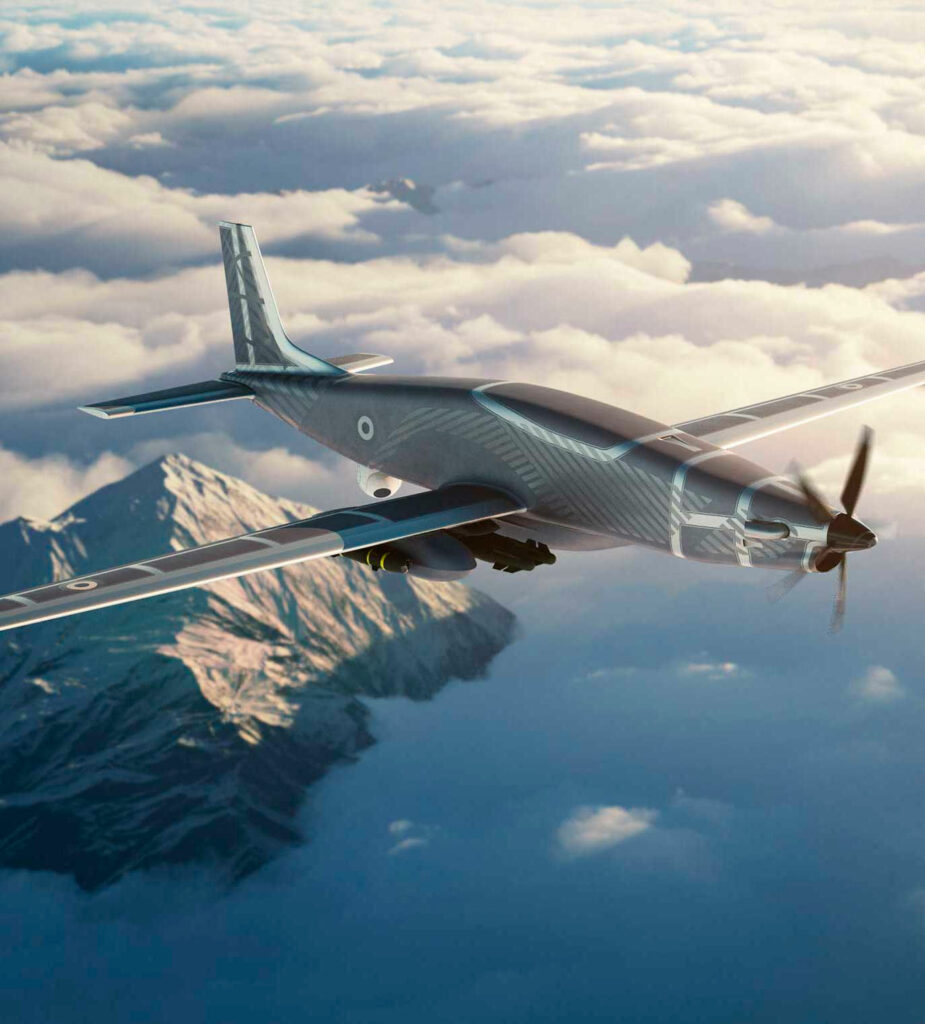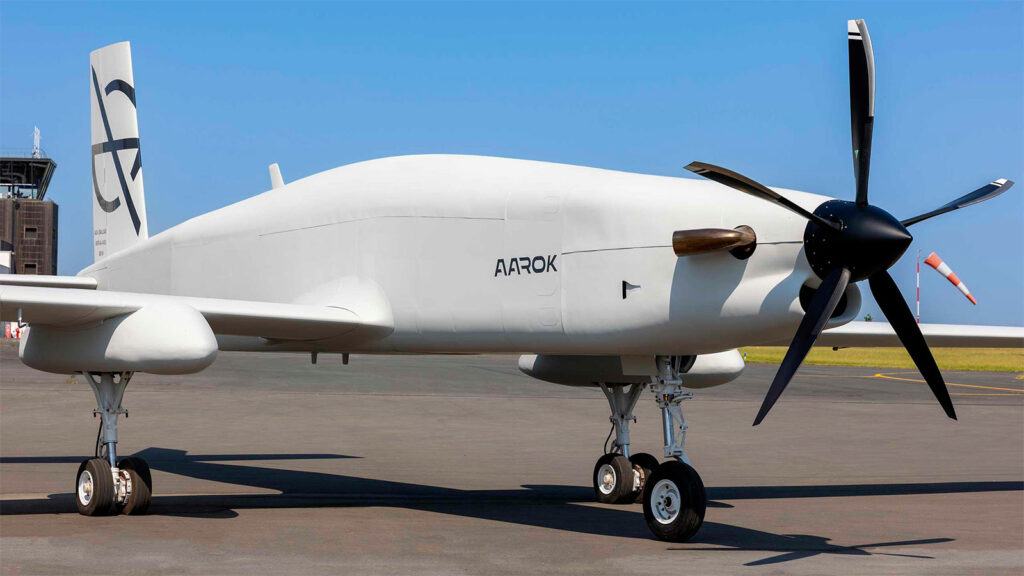The TG AAROK (ASA 1204) is a French-developed 5.5-ton MALE UAV featuring a 1,200 hp turboprop engine, 24-hour endurance, and multi-role capabilities.
The TG AAROK (ASA 1204) is a French Medium-Altitude, Long-Endurance (MALE) Unmanned Aerial Vehicle (UAV) developed by Turgis & Gaillard. Designed for versatility, it serves both surveillance and combat roles. Powered by a 1,200 horsepower turboprop engine, the AAROK boasts a maximum takeoff weight of 5.5 tons and an endurance exceeding 20 hours. It features a wingspan of 22 meters (72 feet) and is equipped with advanced optronic sensors, multimode radar, and signals intelligence (SIGINT) equipment. The UAV can carry up to 500 kilograms (1,102 pounds) of precision-guided munitions across four underwing hardpoints, enabling it to perform missions such as close air support, air interdiction, and suppression of enemy air defenses. Its all-weather capability and automatic takeoff and landing systems enhance operational flexibility. The AAROK is designed to be a cost-effective alternative to existing UAVs, utilizing readily available, qualified technology from leading European manufacturers.

History of Development
In the early 2020s, the global defense landscape witnessed a growing reliance on unmanned systems for intelligence, surveillance, reconnaissance, and combat roles. Recognizing the need for a domestically developed UAV to reduce dependence on foreign technology, France initiated the development of the TG AAROK (ASA 1204). The project commenced in June 2020, spearheaded by Turgis & Gaillard, a company with extensive experience in defense systems. The development was conducted with the support of the French Directorate General of Armaments (DGA), aiming to create a UAV that could meet the specific requirements of the French Armed Forces and appeal to international markets. The prototype was assembled in Blois, Loir-et-Cher, and was first unveiled to the public at the Paris Air Show in June 2023. By April 2024, the AAROK had successfully commenced ground testing, with plans for its maiden flight anticipated in late 2024.
Design
The TG AAROK (ASA 1204) features a conventional aircraft design optimized for unmanned operations. It has a wingspan of 22 meters (72 feet) and a length of 14 meters (46 feet), providing a stable platform for various mission profiles. The airframe is constructed to withstand operations from unprepared runways, with a robust undercarriage suitable for unpaved surfaces. The UAV is powered by a 1,200 horsepower turboprop engine, which drives a five-bladed propeller located at the nose. This propulsion system enables a cruising speed of over 240 knots (450 km/h) and a service ceiling exceeding 45,000 feet (13,716 meters). The AAROK is equipped with advanced avionics, including automatic takeoff and landing capabilities, and is designed for all-weather operations, including known icing conditions. Its modular design allows for the integration of various payloads, such as optronic sensors, multimode radar, and SIGINT equipment, enhancing its versatility across multiple mission types.
Performance
The TG AAROK (ASA 1204) is engineered to deliver exceptional performance in its class. With a maximum takeoff weight of 5.5 tons (12,125 pounds) and an empty weight of 2.5 tons (5,511 pounds), it can carry nearly 3 tons (6,614 pounds) of fuel, weapons, and mission-specific equipment. The UAV’s endurance exceeds 20 hours, allowing for extended missions without the need for refueling. Its cruising speed surpasses 240 knots (450 km/h), facilitating rapid deployment to operational areas. The service ceiling is above 45,000 feet (13,716 meters), enabling operations above commercial air traffic and providing a tactical advantage in surveillance missions. Compared to contemporaries like the General Atomics MQ-9 Reaper, which has a maximum speed of approximately 240 knots (444 km/h) and an endurance of around 27 hours, the AAROK offers competitive performance metrics. Its combination of speed, endurance, and payload capacity positions it as a formidable competitor in the MALE UAV market.
Variants
As of now, the TG AAROK (ASA 1204) is primarily offered in its base configuration, designed to fulfill a wide range of missions through its modular payload capabilities. This standard variant is equipped with four underwing hardpoints capable of carrying up to 500 kilograms (1,102 pounds) of ordnance, including precision-guided munitions and air-to-surface missiles. The UAV’s design allows for future adaptations and the development of specialized variants to meet specific operational requirements, such as enhanced electronic warfare capabilities or extended-range configurations. Turgis & Gaillard has indicated that the AAROK’s architecture supports the integration of various mission-specific modules, enabling rapid reconfiguration to address emerging threats and mission profiles.

Military Missions
The TG AAROK (ASA 1204) is designed to execute a diverse array of military missions, leveraging its advanced sensor suite and armament capabilities. It is optimized for Intelligence, Surveillance, and Reconnaissance (ISR) operations, employing high-resolution electro-optical and infrared (EO/IR) cameras, synthetic aperture radar (SAR), and signals intelligence (SIGINT) payloads to gather real-time intelligence. Its multimode radar allows for target acquisition, battlefield surveillance, and maritime patrol missions, making it a versatile asset for military forces.
For combat operations, the AAROK can carry up to 500 kilograms (1,102 pounds) of ordnance across four underwing hardpoints, including precision-guided munitions (PGMs), anti-armor missiles, and air-to-ground munitions. It is expected to integrate MBDA’s AASM Hammer, Brimstone, or AGM-114 Hellfire missiles, offering precision strike capabilities against armored vehicles, fortified positions, and enemy infrastructure.
In counterinsurgency and suppression of enemy air defense (SEAD) missions, the UAV can neutralize radar installations and enemy strongholds using its long-endurance loitering capability to track and strike targets efficiently. Additionally, its ability to operate in maritime environments allows it to conduct anti-ship and anti-submarine warfare, deploying specialized sensors and munitions for naval operations.
The AAROK also features encrypted battlefield communications, allowing seamless integration with allied forces. Beyond-line-of-sight (BLOS) capabilities ensure extended-range operations, supporting special forces, border surveillance, and counterterrorism efforts.
Competing UAVs include the General Atomics MQ-9 Reaper, Bayraktar Akıncı, and Chinese Wing Loong II, all of which serve similar roles. However, the AAROK aims to offer a cost-effective European alternative, reducing dependency on U.S. or Turkish systems.
France is expected to operate the AAROK within its armed forces, and potential export customers may include European and Middle Eastern nations seeking high-performance UAVs with low operational costs. With its modular design and integration of NATO-standard weaponry and sensors, it positions itself as a flexible and scalable solution for modern warfare.
Final word
The TG AAROK (ASA 1204) is a highly capable MALE UAV, developed to address the increasing demand for long-endurance surveillance and precision strike capabilities. Its 1,200 hp turboprop engine, 22-meter wingspan, and endurance of over 20 hours provide a solid balance between speed, range, and payload capacity. The UAV’s modular architecture supports ISR, strike missions, and maritime operations, making it a direct competitor to U.S. and Turkish UAVs.
The integration of advanced avionics, SIGINT, EO/IR sensors, and encrypted communications enhances its effectiveness in network-centric warfare, supporting real-time intelligence gathering and rapid precision strikes. The AAROK’s affordability and reliance on European technologies make it an attractive option for NATO and allied forces. With ongoing development, potential variants and upgrades could further extend its capabilities, reinforcing its position in the growing UAV market.
Back to the Drones, UAVs, UCAVs page